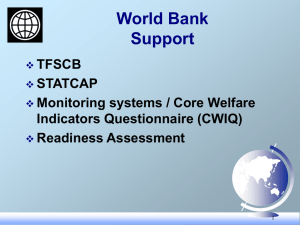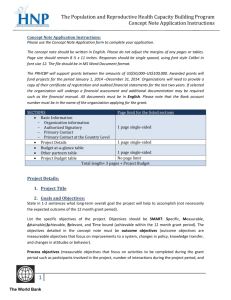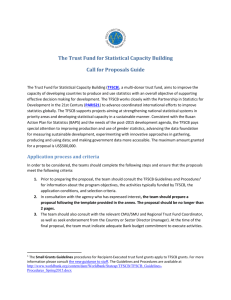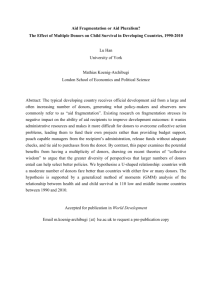The World Bank and Statistical Capacity Building
advertisement
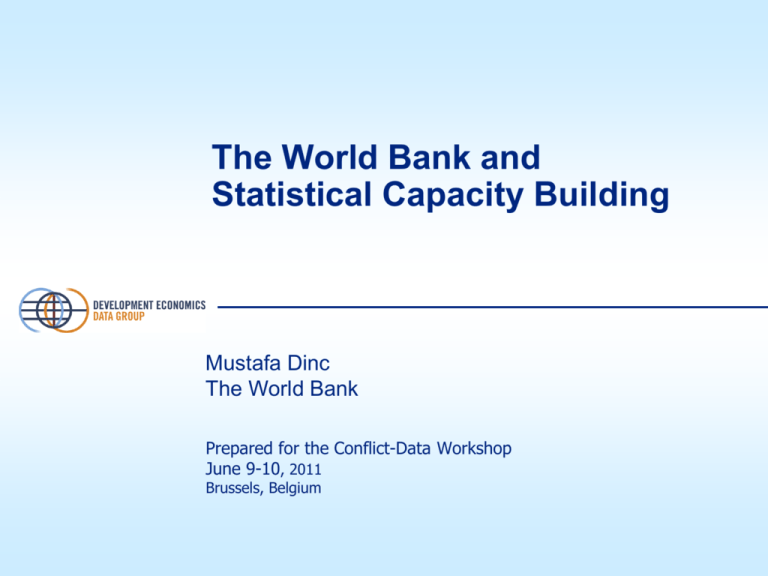
The World Bank and Statistical Capacity Building Mustafa Dinc The World Bank Prepared for the Conflict-Data Workshop June 9-10, 2011 Brussels, Belgium Some Key Issues • Statistical capacity improvement is not on top of the • • • • • priority list, Overall levels of financing for capacity improvement in statistics remain low, Special interests of donors, often sectoral, tend to get priority – results in a piecemeal approach, Technical expertise is relatively scarce, Statistical offices not always in a good position to coordinate and harmonize donor programs, Lack of coordination and cooperation among development partners. Vicious Cycle Weak statistical systems Low investment in statistics Poor quality data and dissemination Donors and others create parallel systems Weak demand incountry New Approach • Coordinate support for statistics through a “sector wide • • • • • • approach”, Increase funding for statistics, Coordinate technical assistance to NSOs, Build on existing mechanisms and programs, with improved monitoring and feedback, Focus on implementation of country-owned strategies, Pool donor funding to support country-led programs, Target countries with weak statistical systems and with a commitment to change. Funding Options for Investment • Government • Bilateral donors • Multilateral Development Banks • Other multilateral donors Programs for Supporting Statistical Capacity Development • Trust Fund for Statistical Capacity Building (TFSCB) • Statistics for Results Facility Catalytic Fund (SRF) • Lending operations, including the STATCAP program • Accelerated Data Program (ADP) • Virtual Statistical System (VSS) • Bulletin Board on Statistical Capacity • E-learning course Trust Fund for Statistical Capacity Building (TFSCB) • Provides grants up to $500,000 for developing countries to strengthen the capacity of their statistical systems in : • Preparation of NSDS (fast-track approval) • Other statistical capacity building activities (approval twice a year, April/November) • Can be country-specific, regional or global • 192 project were approved since 2000 SRF Catalytic Fund • Multi-donor trust fund for large-scale investment in statistical development • Provides “catalytic” grants to help poor countries implement NSDSs • Promotes a Sector-Wide Approach and better aid effectiveness • Requires close alignment to statistical needs of national development policy • Grants normally expected to be in 5m–10m range Lending Operations and STATCAP • STATCAP program provides framework for • • • • supporting implementation of NSDS with regular lending operations Since 2004 $239m approved under STATCAP (10 countries) $107m in India (DPL) $42m approved (following STATCAP guidelines) as components of larger operations (2 countries) Pipeline of $150m • See www.worldbank.org/data/statcap Accelerated Data Program (ADP) To better use of existing microdata and to Improve data collection ADP has three tasks; • Data archive • • • • Inventory of existing datasets Documentation Dissemination Cataloguing • Improving quality • Assessment of data quality, and harmonization of data collection practices • Data collection • Limited budget, only to “rescue” operations Bulletin Board on Statistical Capacity • New on-line database • Collects and presents key information on national • • • • • statistical systems, to facilitate assessment of statistical capacity Includes all developing countries (but focus on IDA countries) Database easy to update by countries, through interactive features Uses existing assessment frameworks, including the African Statistical Development Index of UNECA Useful for self-assessment and monitoring of progress See www.worldbank.org/data/bbsc The Bulletin Board on Statistical Capacity www.worldbank.org/data/bbsc E-learning on Statistical Capacity • An online and CD-ROM based self-learning course • Provides knowledge and skills to develop and manage • • • • • successful statistical development projects Targeted at managers and staff in national statistical agencies and international development agencies 12 modules, includes exercises, background reading, links to tools and resources Full course currently in English; some modules are available in French and Spanish on CDROM Translation of full course to French is underway Course is free: to receive CD-ROM or access on-line, send email to invstatcap@worldbank.org Contact: Mdinc@worldbank.org
